Failure Characteristics and Mechanism of Nano-Modified Oil-Impregnated Paper Subjected to Repeated Impulse Voltage
Abstract
1. Introduction
2. Experimental Setup
2.1. Preparation of Nanofluids
2.2. Breakdown Test Platform and Test Method
2.3. Measurement Parameters
2.3.1. Pulsed Electro-Acoustic (PEA)
- Apply repeated impulse voltage to the OIP sample and NOIP sample with different nanoparticle concentrations.
- Transfer the test sample to the PEA measurement system. The transfer interval time is less than 15 s.
- Measure the space charge distribution of NOIP/OIP sample at a specified time.
2.3.2. Thermally Stimulated Current (TSC)
2.3.3. Atomic Force Microscope Measurement (AFM)
2.3.4. Mercury Intrusion Micropore Structure Measurement
3. Effect of Nanoparticles on the Electrical Performance of NMTO and NOIP
3.1. Breakdown Characteristics of NMTO
3.2. Breakdown Characteristics of NOIP
3.3. Accumulative Failure Characteristics of NOIP
4. Analysis and Discussion
4.1. Failure Mechanism of OIP under Repeated Impulses
- Space charge accumulation: under repeated lightning impulse voltage, positive space charges are injected into the OIP sample and migrate toward cathode. In this process, some of the positive space charges are trapped in the dielectric. Conversely, negative charges, which mainly consist of electrons, can easily pass through the dielectric and be neutralized in the anode. The existence of positive charges in the bulk strengthen the electric field near the cathode, thereby contributing to the breakdown of the OIP.
- Dielectric accumulative damage: when the impulse voltage is applied to the OIP sample, the electric field intensity in the oil pores becomes extremely high. Partial discharge occurs repeatedly in the oil pores. When the charged particles and electrons collide, some of the cellulose fibers break and form a new substance. In this process, the cellulose paper suffers unrecoverable damage, thereby leading to the decrease in the breakdown voltage of the OIP [22].
4.2. Space Charge Distribution in OIP and NOIP
- The space charge density of NOIP is much lower than that of OIP.
- Positive charges were detected on the paper interface between the 2nd layer and the 3rd layer in the OIP sample. Whereas in the NOIP sample, negative charges were observed on this paper interface.
4.3. Microstructure of OIP/NOIP
4.3.1. Surface Micromorphology
4.3.2. Micropore Structure
5. Conclusions
6. Follow-Up Work and Research Progress
Author Contributions
Funding
Conflicts of Interest
References
- Mansour, D.A.; Elsaeed, A.M.; Izzularab, M.A. The role of interfacial zone in dielectric properties of transformer oil-based nanofluids. IEEE Trans. Dielectr. Electr. Insul. 2016, 23, 3364–3372. [Google Scholar] [CrossRef]
- Du, B.; Li, X.; Xiao, M. High thermal conductivity transformer oil filled with BN nanoparticles. IEEE Trans. Dielectr. Electr. Insul. 2015, 22, 851–858. [Google Scholar] [CrossRef]
- Shukla, G.; Aiyer, H. Thermal conductivity enhancement of transformer oil using functionalized nanodiamonds. IEEE Trans. Dielectr. Electr. Insul. 2015, 22, 2185–2190. [Google Scholar] [CrossRef]
- Lin, S.; Liu, L.; Liang, Y.; Cui, W.; Zhang, Z. Oil-in-water self-assembled synthesis of Ag@AgCl nano-particles on flower-like Bi2O2CO3 with enhanced visible-light-driven photocatalytic activity. Materials 2016, 9, 486. [Google Scholar] [CrossRef] [PubMed]
- Zheng, L.; Yuan, L.; Guan, Q.; Gu, A.; Liang, G. Fabrication and origin of asymmetric polyvinylidene fluoride-carbon nanotube/cyanate ester materials with high dielectric constant and low dielectric loss through building double-layered structure. IET High Volt. 2017, 2, 32–38. [Google Scholar] [CrossRef]
- Wan, F.; Shi, H.; Chen, W.; Gu, Z.; Du, L. Charge transfer effect on Raman and surface enhanced Raman spectroscopy of furfural molecules. Nanomaterials 2017, 7, 210. [Google Scholar] [CrossRef] [PubMed]
- Segal, V.; Hjortsberg, A.; Rabinovich, A.; Nattrass, D. AC (60 Hz) and impulse breakdown strength of a colloidal fluid based on transformer oil and magnetite nanoparticles. In Proceedings of the IEEE International Symposium on Electrical Insulation, Eindhoven, The Netherlands, 17–21 August 1998; pp. 619–622. [Google Scholar]
- George Hwang, J.; Zahn, M.; O’Sullivan, F.M.; Pettersson, L.A.A.; Hjortstam, O.; Liu, R. Effects of nanoparticle charging on streamer development in transformer oil-based nanofluids. J. Appl. Phys. 2010, 107, 014310. [Google Scholar] [CrossRef]
- Jin, H.; Andritsch, T.; Tsekmes, I.; Kochetov, R.; Morshuis, P. Properties of mineral oil based silica nanofluids. IEEE Trans. Dielectr. Electr. Insul. 2014, 21, 1100–1108. [Google Scholar]
- Du, Y.; Lv, Y.; Li, C.; Chen, M.; Zhou, Y.; Zhou, J.; Li, X.; Zhou, Y. Effect of semiconductive nanoparticles on insulating performances of transformer oil. IEEE Trans. Dielectr. Electr. Insul. 2012, 19, 770–776. [Google Scholar]
- Amiri, A.; Kazi, S.; Shanbedi, M.; Zubir, M.; Yarmand, H. Transformer oil based multi-walled carbon nanotube–hexylamine coolant with optimized electrical, thermal and rheological enhancements. RSC Adv. 2015, 5, 107222–107236. [Google Scholar] [CrossRef]
- Lee, J.C.; Lee, W.H.; Lee, S.H.; Lee, S. Positive and negative effects of dielectric breakdown in transformer oil based magnetic fluids. Mater. Res. Bull. 2012, 47, 2984–2987. [Google Scholar] [CrossRef]
- Sartoratto, P.; Neto, A.; Lima, E.; Lima, E. Preparation and electrical properties of oil-based magnetic fluids. J. Appl. Phys. 2005, 97, 513. [Google Scholar] [CrossRef]
- Atiya, E.G.; Mansour, D.E.A.; Khattab, R.M.; Azmy, A.M. Dispersion behavior and breakdown strength of transformer oil filled with TiO2 nanoparticles. IEEE Trans. Dielectr. Electr. Insul. 2015, 22, 2463–2472. [Google Scholar] [CrossRef]
- Sun, P.; Sima, W.; Chen, J.; Zhang, D.; Jiang, X.; Chen, Q. An application area of C60: Overall improvement of insulating oil’s electrical performance. Appl. Phys. Lett. 2018, 112, 142902. [Google Scholar] [CrossRef]
- Kudelcik, J.; Bury, P.; Kopcansky, P.; Timko, M. Dielectric breakdown in mineral oil ITO 100 based magnetic fluid. Phys. Proced. 2010, 9, 78–81. [Google Scholar] [CrossRef]
- Wang, Y.; Wang, C.; Zhang, Z.; Xiao, K. Effect of nanoparticles on the morphology, thermal, and electrical properties of low-density polyethylene after thermal aging. Nanomaterials 2017, 7, 320. [Google Scholar] [CrossRef] [PubMed]
- Alvarez, N.; Ochmann, T.; Kienzle, N.; Ruff, B.; Haase, M. Polymer coating of carbon nanotube fibers for electric microcables. Nanomaterials 2014, 4, 879–893. [Google Scholar] [CrossRef] [PubMed]
- Shang, N.; Chen, Q.; Wei, X. Preparation and dielectric properties of SiC/LSR nanocomposites for insulation of high voltage direct current cable accessories. Materials 2018, 11, 403. [Google Scholar] [CrossRef] [PubMed]
- Jing, Z.; Li, C.; Zhao, H.; Zhang, G.; Han, B. Doping effect of graphene nanoplatelets on electrical insulation properties of polyethylene: From macroscopic to molecular scale. Materials 2016, 9, 680. [Google Scholar] [CrossRef] [PubMed]
- Wei, Y.; Zhao, J.; Phung, B.; Faupel, F.; Ostrikov, K. High-voltage insulation organic-inorganic nanocomposites by plasma polymerization. Materials 2014, 7, 563. [Google Scholar]
- Sima, W.; Sun, P.; Yang, Q.; Yuan, T.; Lu, C.; Yang, M. Study on the accumulative effect of repeated lightning impulses on insulation characteristics of transformer oil impregnated paper. IEEE Trans. Dielectr. Electr. Insul. 2014, 21, 1933–1941. [Google Scholar] [CrossRef]
- Sima, W.; Sun, P.; Yang, M.; Yang, Q.; Wu, J. Effect of space charge on the accumulative characteristics of oil paper insulation under repeated lightning impulses. IEEE Trans. Dielectr Electr Insul. 2015, 22, 2483–2490. [Google Scholar] [CrossRef]
- Sun, P.; Sima, W.; Yang, M.; Lan, X.; Wu, J. Study on voltage-number characteristics of transformer insulation under transformer invading non-standard lightning impulses. IEEE Trans. Dielectr. Electr. Insul. 2015, 22, 3582–3591. [Google Scholar] [CrossRef]
- Sima, W.; Sun, P.; Yang, M.; Wu, J.; Hua, J. Impact of time parameters of lightning impulse on the breakdown characteristics of oil paper insulation. IET. High Volt. 2016, 1, 18–24. [Google Scholar] [CrossRef]
- Sun, P.; Sima, W.; Yang, M.; Wu, J.; Hua, J. Accumulative effect of repeated lightning impulses on transformer insulation: Mechanism analysis. IEEE Trans. Dielectr. Electr. Insul. 2016, 23, 2430–2437. [Google Scholar] [CrossRef]
- Standard Test Method for Dielectric Breakdown Voltage of Insulating Oils of Petroleum Origin under Impulse Conditions; ASTM D3487-2000(II); ASTM International: West Conshohocken, PA, USA, 2000.
- CIGRE. Effect of Particles on Transformer Dielectric Strength; Working Group 17 of Study Committee 12; CIGRE: Paris, France, 2000. [Google Scholar]
- Li, Y.; Zhu, M.; Mu, H.; Deng, J.; Zhang, G.; Jadidian, J.; Zahn, M.; Zhang, W.; Li, Z. Transformer oil breakdown dynamics stressed by fast impulse voltages: Experimental and modeling investigation. IEEE Trans. Plasma Sci. 2014, 24, 3004–3013. [Google Scholar] [CrossRef]
- Finis, G.; Claudi, A. On the dielectric breakdown behavior of silicone gel under various stress conditions. IEEE Trans. Dielectr. Electr. Insul. 2007, 14, 487–494. [Google Scholar] [CrossRef]
- Borsi, H. Dielectric behavior of silicone and ester fluids for use in distribution transformers. IEEE Trans. Dielectr. Electr. Insul. 1991, 26, 755–762. [Google Scholar] [CrossRef]
- Liu, Q.; Wang, Z.D. Breakdown and withstand strengths of ester transformer liquids in a quasi-uniform field under impulse voltages. IEEE Trans. Dielectr. Electr. Insul. 2013, 20, 571–579. [Google Scholar] [CrossRef]
- Liu, R.; Jaksts, A. Breakdown processes in transformer insulation under LI voltages. In Proceedings of the IEEE Conference on Dielectric Liquids, Coimbra, Portugal, 26 June–1 July 2005; pp. 75–78. [Google Scholar]
- Lv, Y.; Zhou, Y.; Li, C.; Wang, Q.; Qi, B. Recent progress in nanofluids based on transformer oil: Preparation and electrical insulation properties. IEEE Trans. Dielectr. Electr. Insul. 2014, 30, 23–32. [Google Scholar] [CrossRef]
- Du, B.; Li, X.; Li, J. Thermal conductivity and dielectric characteristics of transformer oil filled with BN and Fe3O4 nanoparticles. IEEE Trans. Dielectr. Electr. Insul. 2015, 22, 2530–2536. [Google Scholar] [CrossRef]
- Swati, K.; Yadav, K.S.; Sarathi, R.; Vinu, R.; Danikas, M.G. Understanding Corona discharge activity in titania nanoparticles dispersed in transformer oil under AC and DC voltages. IEEE Trans. Dielectr. Electr. Insul. 2017, 24, 2325–2336. [Google Scholar] [CrossRef]
- Vu, T.T.N.; Teyssedre, G.; Vissouvanadin, B.; Roy, S.L.; Laurent, C. Correlating conductivity and space charge measurements in multi-dielectrics under various electrical and thermal stresses. IEEE Trans. Dielectr. Electr. Insul. 2015, 22, 117–127. [Google Scholar] [CrossRef]
- Luo, H.; Jiao, J.; Liu, K.; Yue, Y.; Wang, X. Characteristics of shallow traps in the dielectric surface and their effects on diffuse dielectric barrier discharge in air. IEEE Trans. Dielectr. Electr. Insul. 2017, 45, 749–753. [Google Scholar] [CrossRef]
- Luo, H.; Liu, K.; Ran, J.; Yue, Y.; Wang, X.; Yap, S.; Wong, C. Study of dielectric barrier Townsend discharge in 3-mm air gap at atmospheric pressure. IEEE Trans. Plasma Sci. 2014, 42, 1211–1215. [Google Scholar]
- Pourrahimi, A.M.; Hoang, T.A.; Liu, D.; Pallon, L.K.; Gubanski, S.; Olsson, R.T.; Gedde, U.W.; Hedenqvist, M.S. Highly efficient interfaces in nanocomposites based on polyethylene and ZnO nano/hierarchical particles: A novel approach toward ultralow electrical conductivity insulations. Adv. Mater. 2016, 28, 8651. [Google Scholar] [CrossRef] [PubMed]
- Nelson, J.K. Dielectric Polymer Nanocomposites; Springer: New York, NY, USA, 2010. [Google Scholar]
- Pourrahimi, A.M.; Olsson, R.T.; Hedenqvist, M.S. The role of interfaces in polyethylene/metal-oxide nanocomposites for ultrahigh-voltage insulating materials. Adv. Mater. 2018, 30, 1703624. [Google Scholar] [CrossRef] [PubMed]
- Dissado, L.A.; Griseri, V.; Peasgood, W.; Cooper, E.S.; Fukunaga, K.; Fothergill, J.C. Decay of space charge in a glassy epoxy resin following voltage removal. IEEE Trans. Dielectr. Electr. Insul. 2006, 13, 903–916. [Google Scholar] [CrossRef]
- Zhou, Y.; Huang, M.; Chen, W.; Lu, L.; Jin, F.; Huang, J. Space charge behavior evolution with thermal aging of oil-paper insulation. IEEE Trans. Dielectr. Electr. Insul. 2015, 22, 1381–1388. [Google Scholar] [CrossRef]
- Pourrahimi, A.M.; Pallon, L.K.; Liu, D.; Hoang, T.A.; Gubanski, S.; Hedenqvist, M.S.; Olsson, R.T.; Gedde, U.W. Polyethylene nanocomposites for the next generation of ultra-low transmission-loss HVDC cables: Insulations containing moisture-resistant MgO nanoparticles. ACS Appl. Mater. Interfaces 2016, 8, 14824. [Google Scholar] [CrossRef] [PubMed]
- Min, D.; Wang, W.; Li, S. Numerical analysis of space charge accumulation and conduction properties in LDPE nanodielectrics. IEEE Trans. Dielectr. Electr. Insul. 2015, 22, 1483. [Google Scholar] [CrossRef]
- Tanaka, T.; Kozako, M.; Fuse, N.; Ohki, Y. Proposal of a multi-core model for polymer nanocomposite dielectrics. IEEE Trans. Dielectr. Electr. Insul. 2005, 12, 669. [Google Scholar] [CrossRef]
- Takada, T.; Hayase, Y.; Tanaka, Y. Space charge trapping in electrical potential well caused by permanent and induced dipoles for LDPE/MgO nanocomposite. IEEE Trans. Dielectr. Electr. Insul. 2008, 15, 152. [Google Scholar] [CrossRef]
- Ruffino, F.; Torrisi, V.; Marletta, G.; Grimaldi, M. Kinetic growth mechanisms of sputter-deposited Au films on mica: From nanoclusters to nanostructured microclusters. Appl. Phys. A 2010, 100, 7–13. [Google Scholar] [CrossRef]
- Ruffino, F.; Torrisi, V.; Marletta, G.; Grimaldi, M. Atomic force microscopy investigation of the kinetic growth mechanisms of sputtered nanostructured Au film on mica: Towards a nanoscale morphology control. Nanoscale Res. Lett. 2011, 6, 112. [Google Scholar] [CrossRef] [PubMed]
- You, H.; Chiarello, R.; Kim, H.; Vandervoort, K. X-ray reflectivity and scanning-tunneling-microscope study of kinetic roughening of sputter-deposited gold films during growth. Phys. Rev. Lett. 1993, 70, 2900. [Google Scholar] [CrossRef] [PubMed]
- Sun, P.; Sima, W.; Yang, M.; Wu, J. Influence of thermal aging on the breakdown characteristics of transformer oil impregnated paper. IEEE Trans. Dielectr. Electr. Insul. 2017, 23, 3373–3381. [Google Scholar] [CrossRef]
- Sun, P.; Sima, W.; Jiang, X.; Zhang, D.; He, J.; Chen, Q. Failure of nano-modified oil impregnated paper under repeated impulse voltage: Effects of TiO2 nanoparticles on space charge characteristics. IEEE Trans. Dielectr. Electr. Insul. 2018. accepted. [Google Scholar]
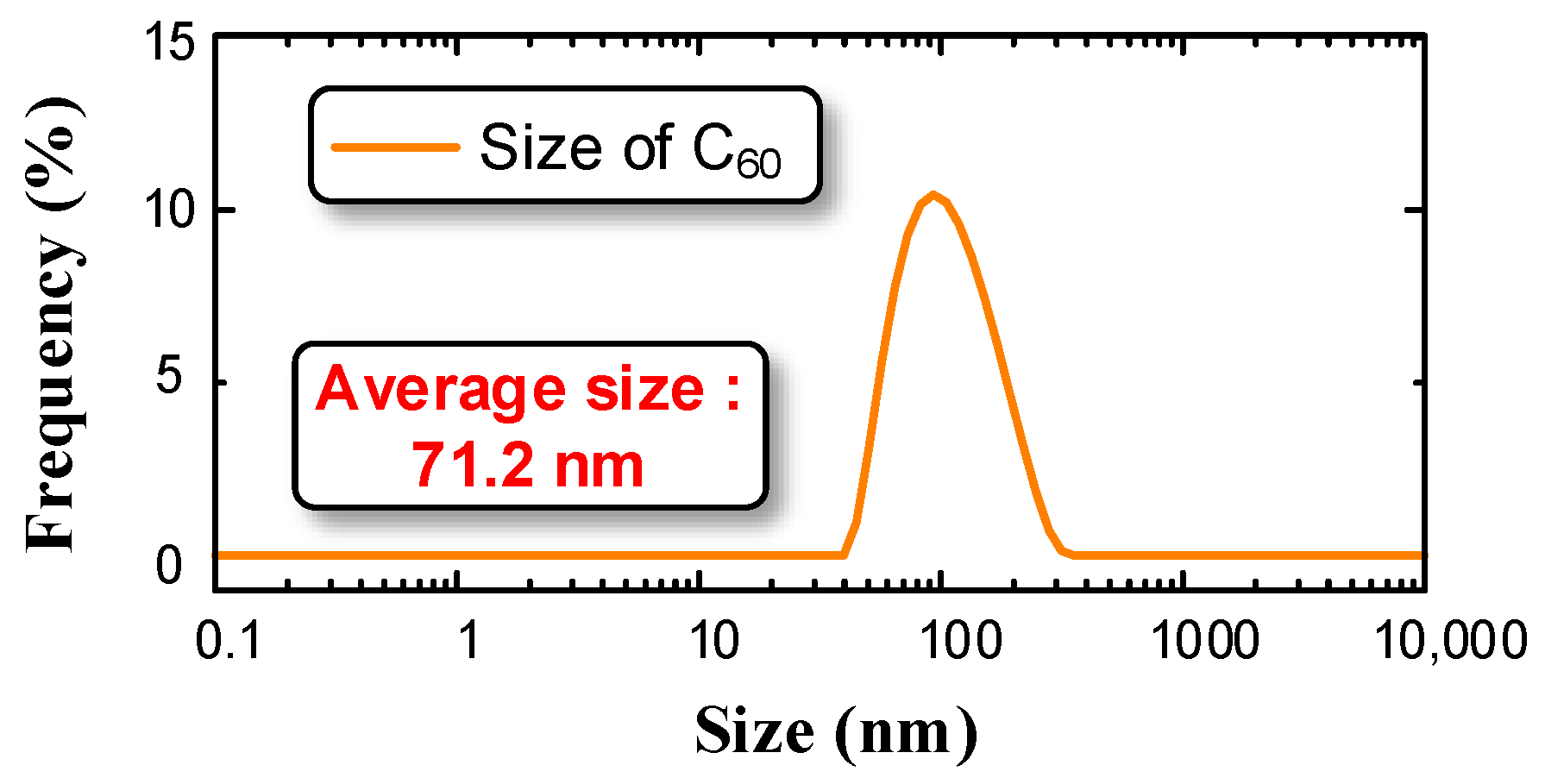
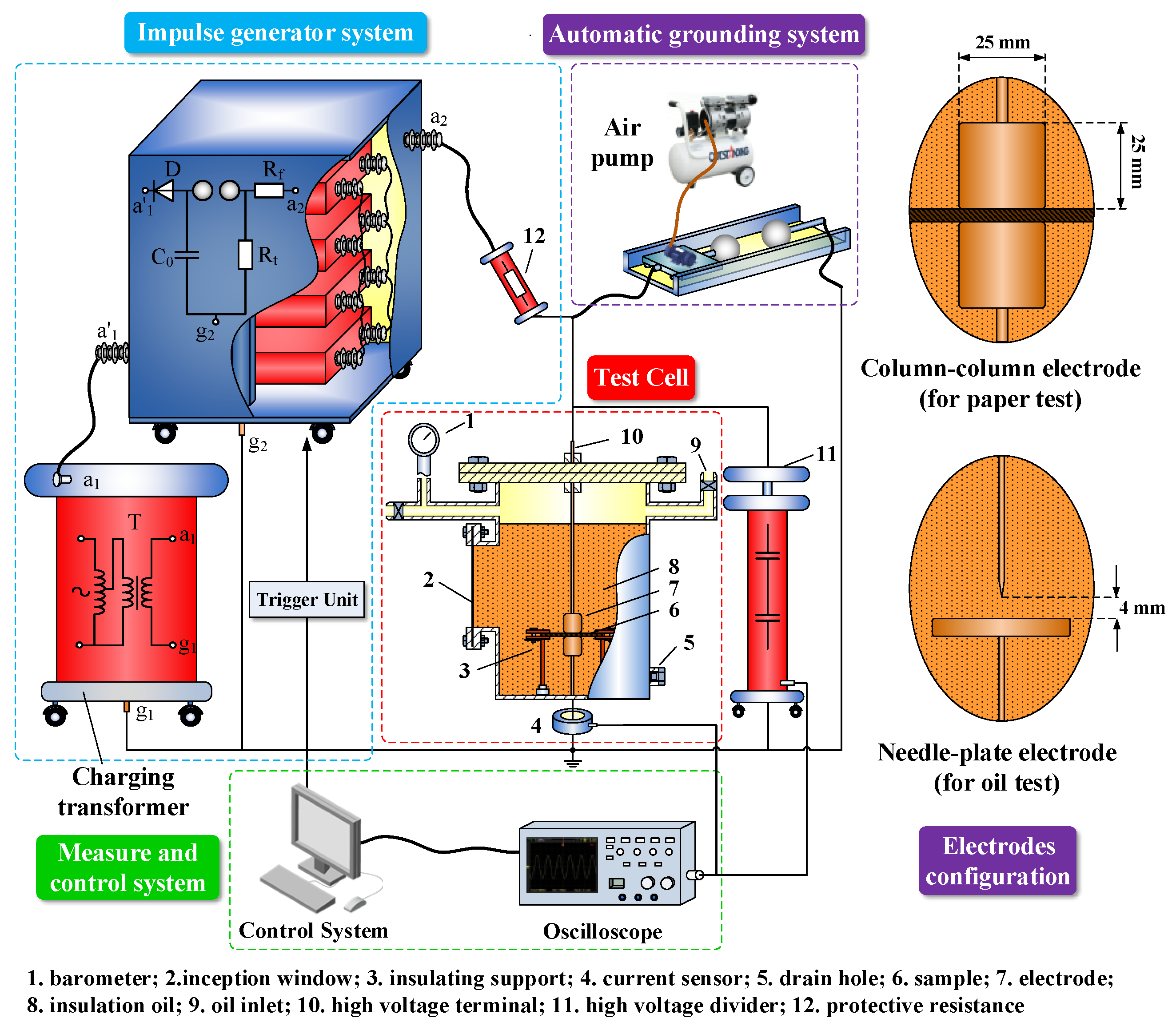
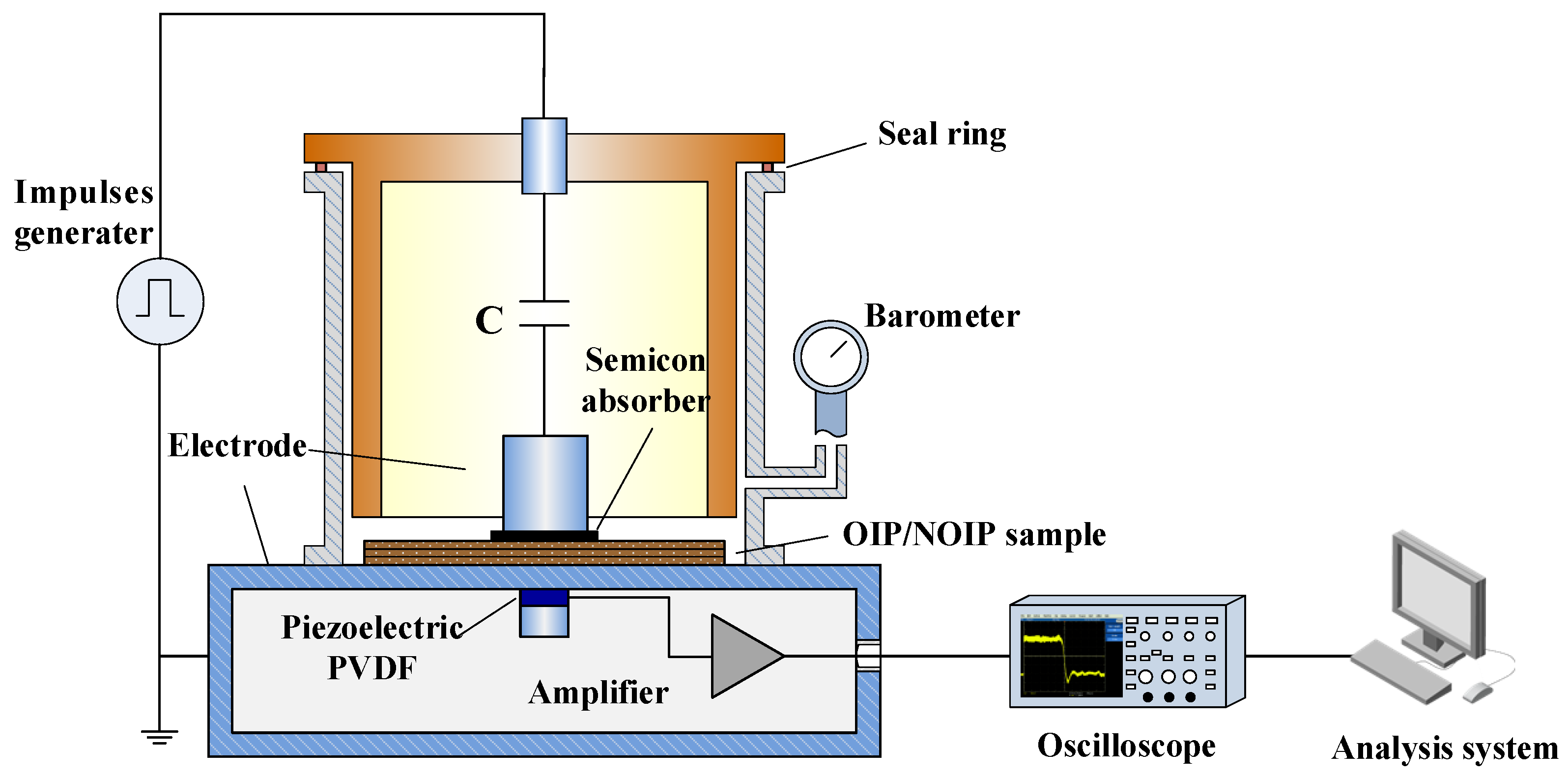
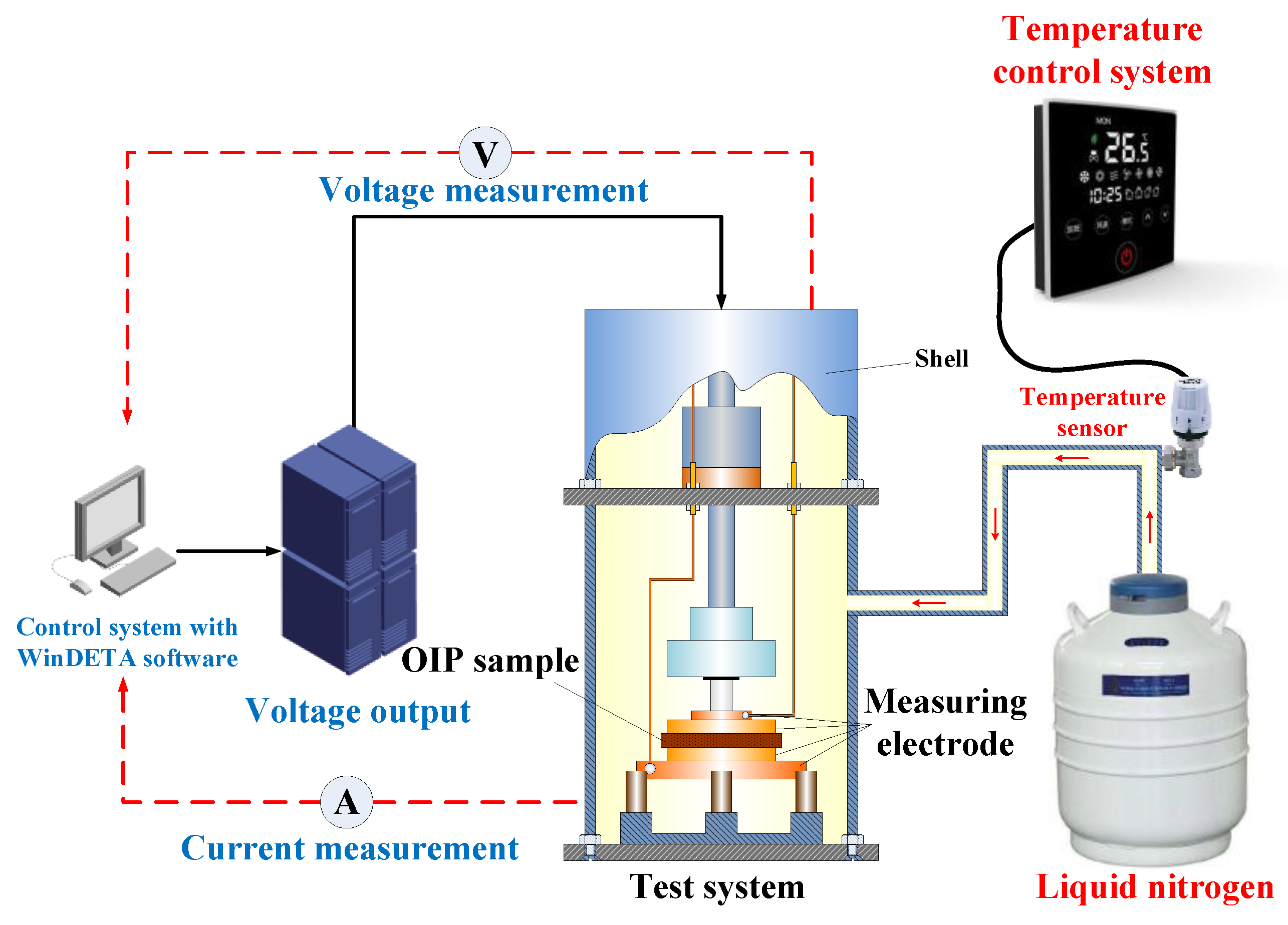
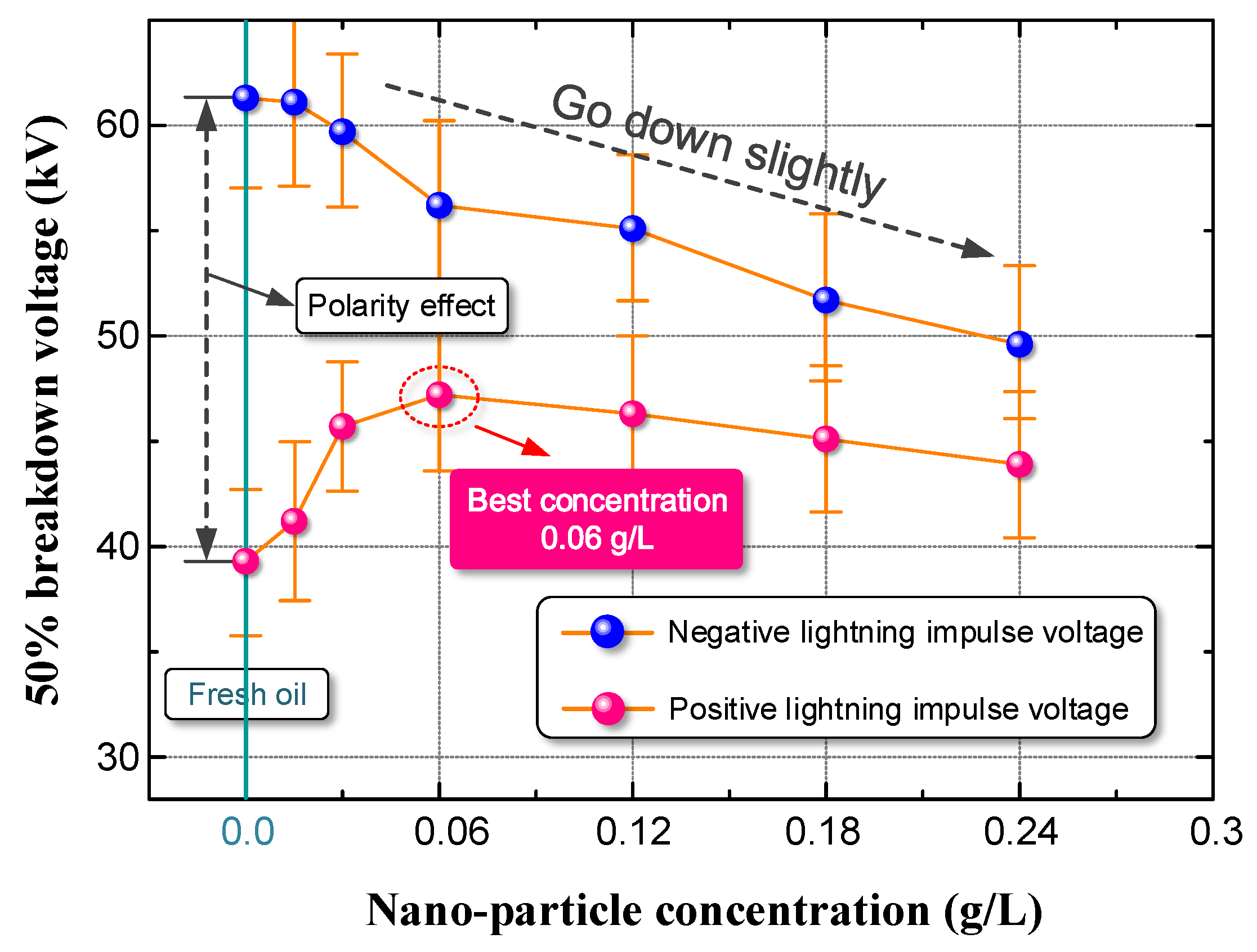
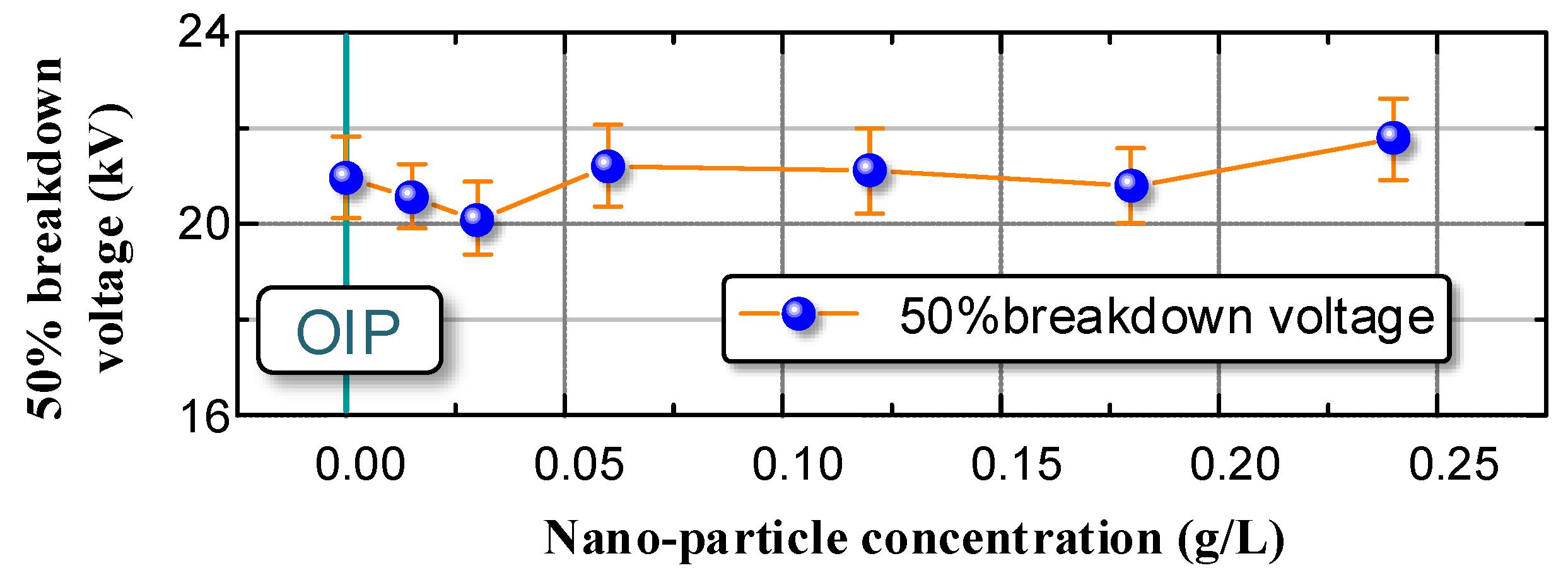
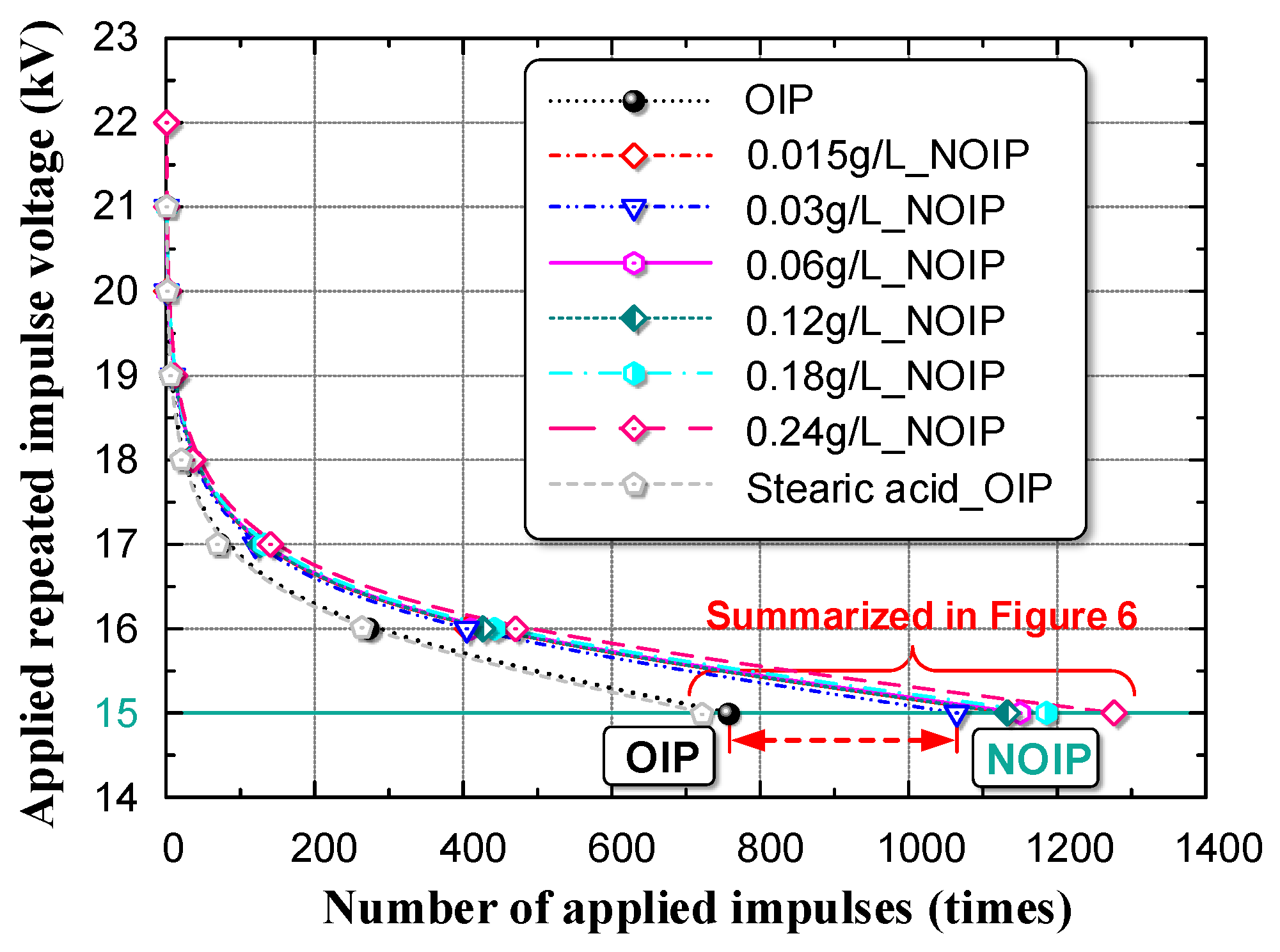
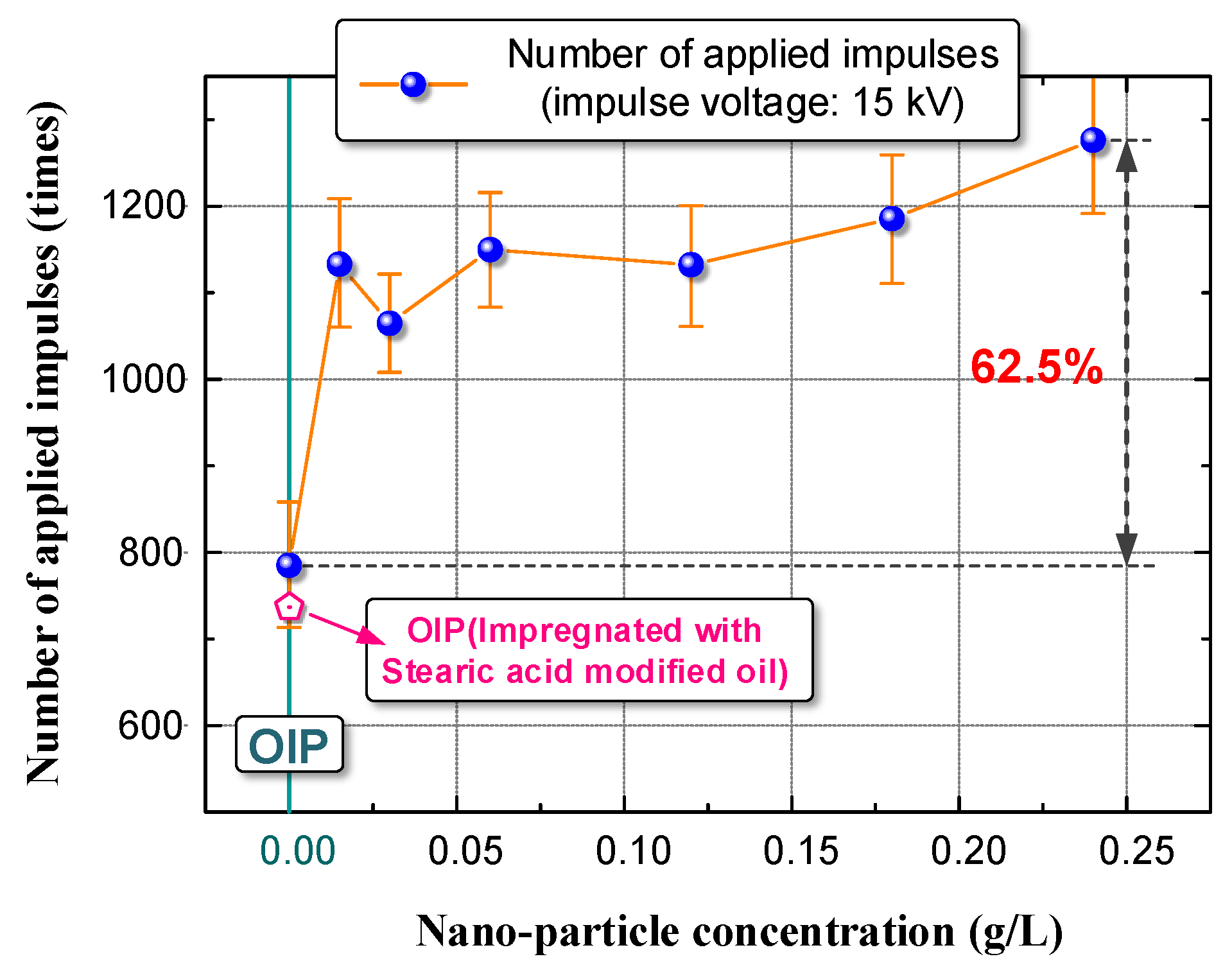
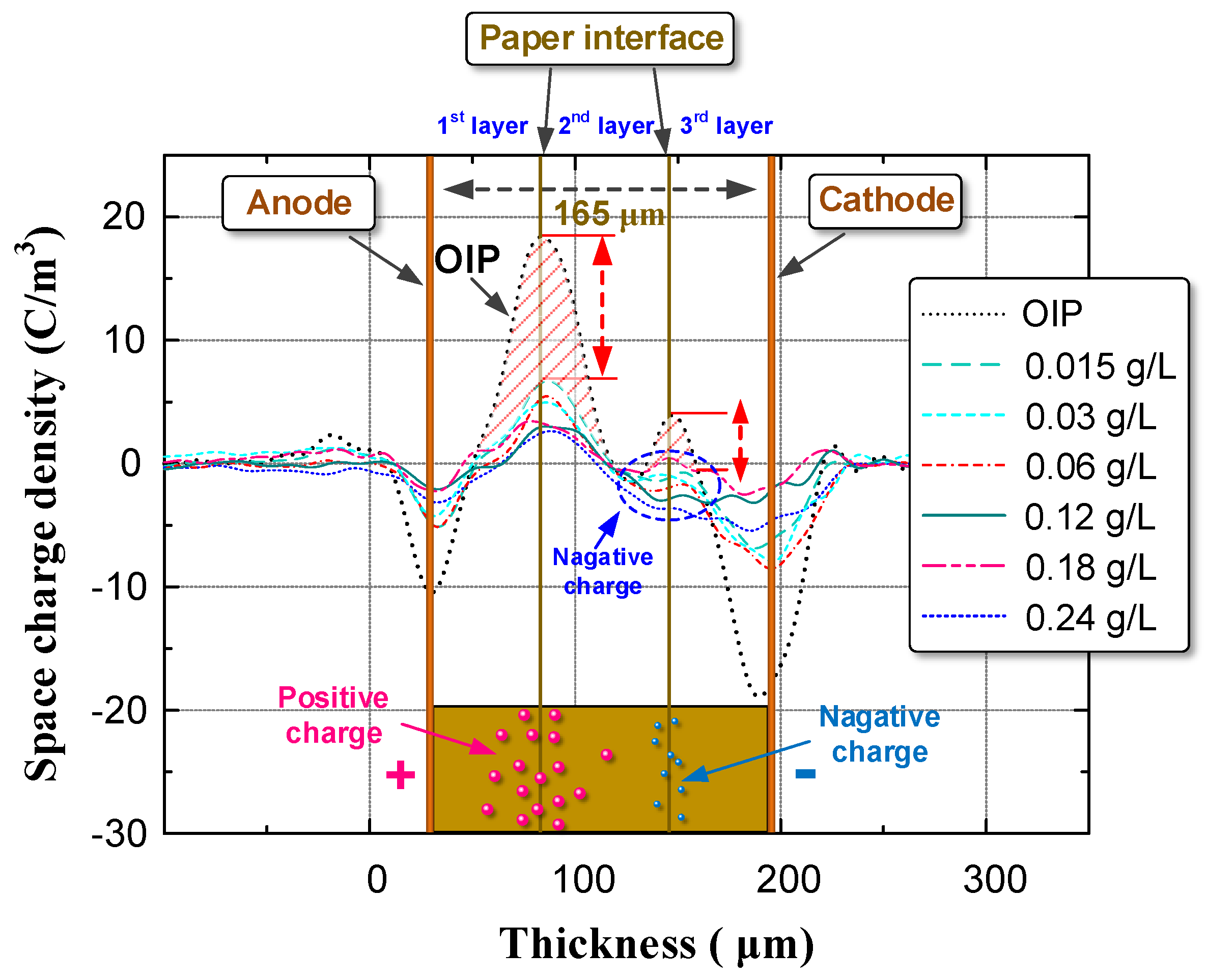
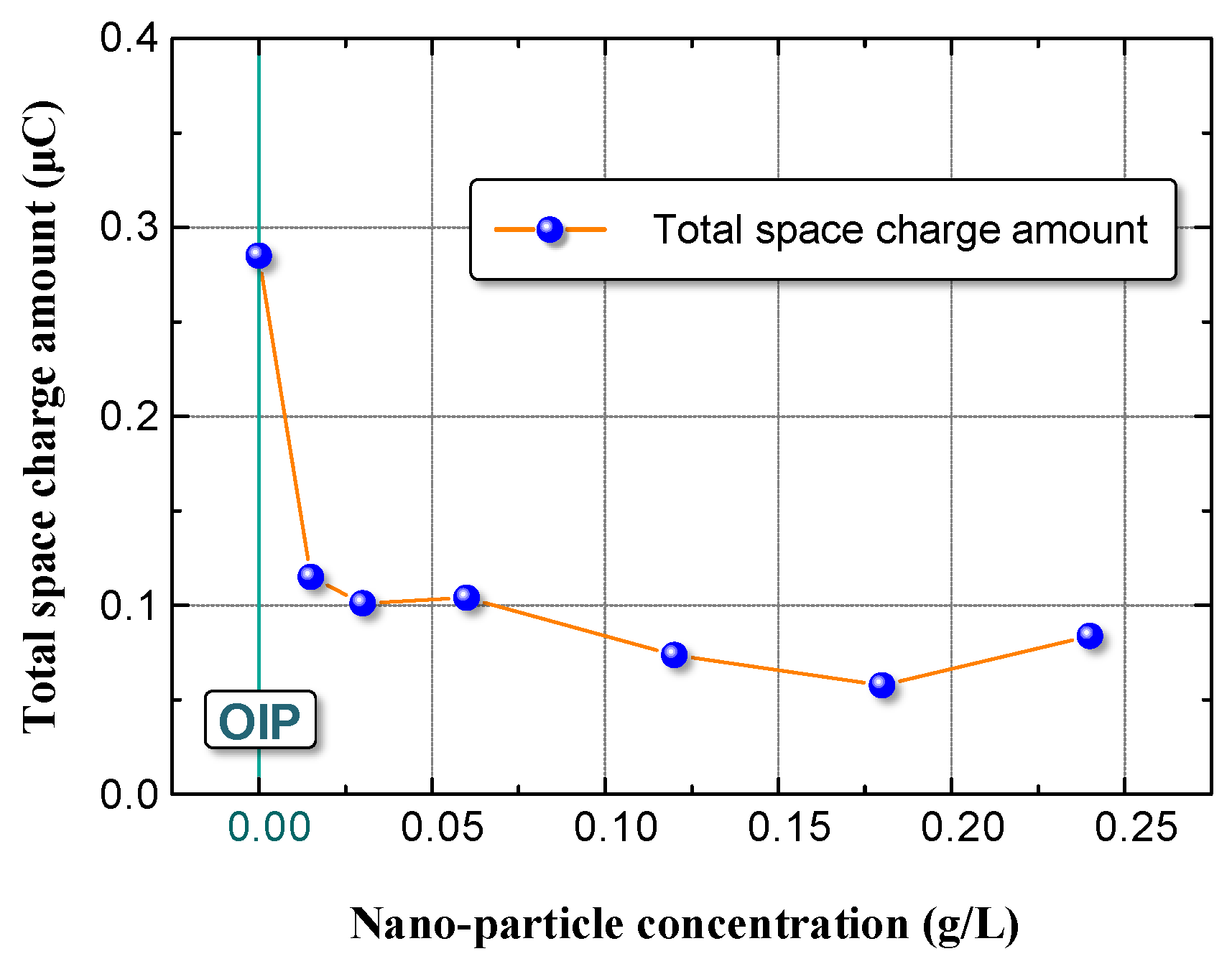
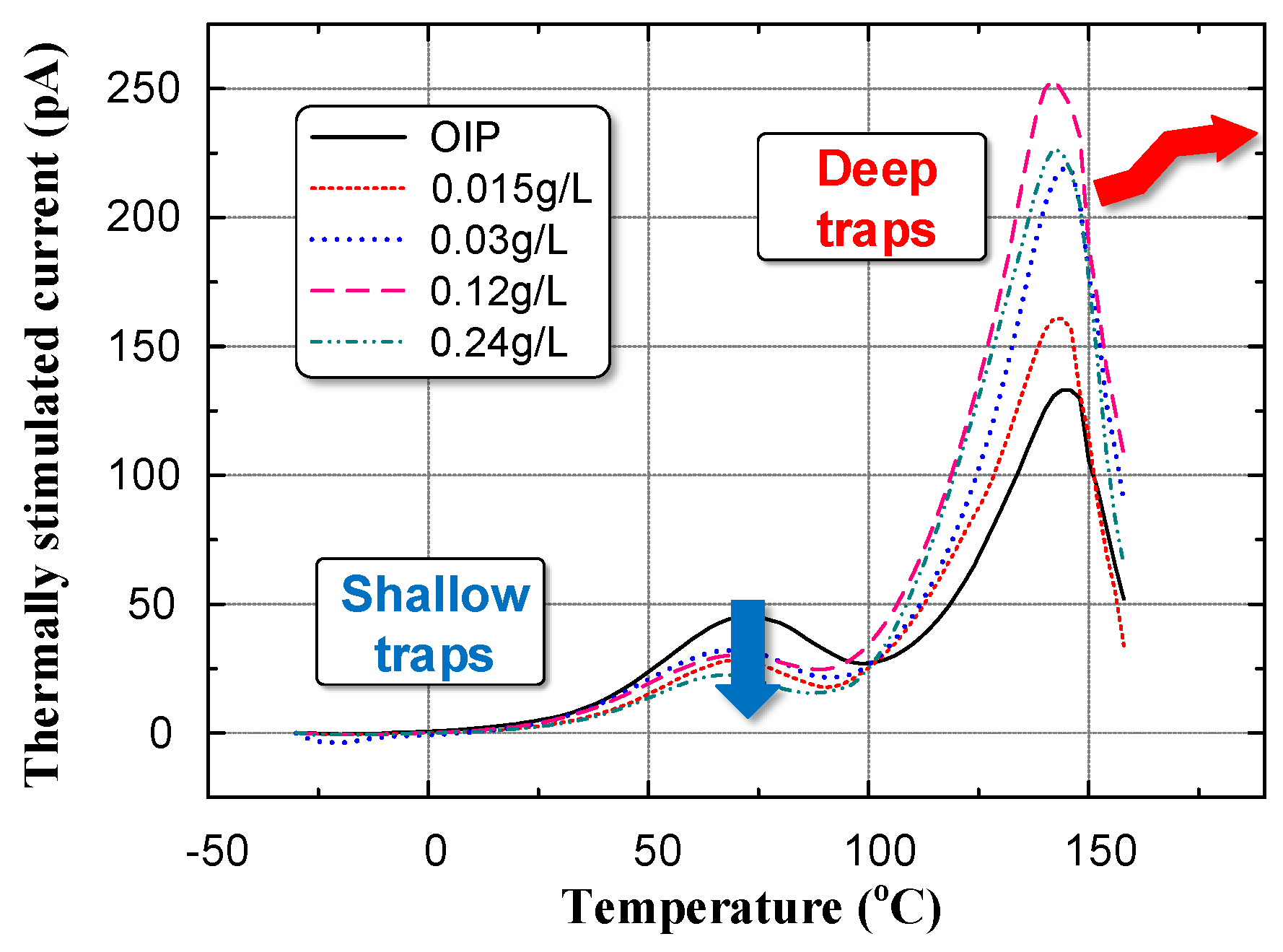

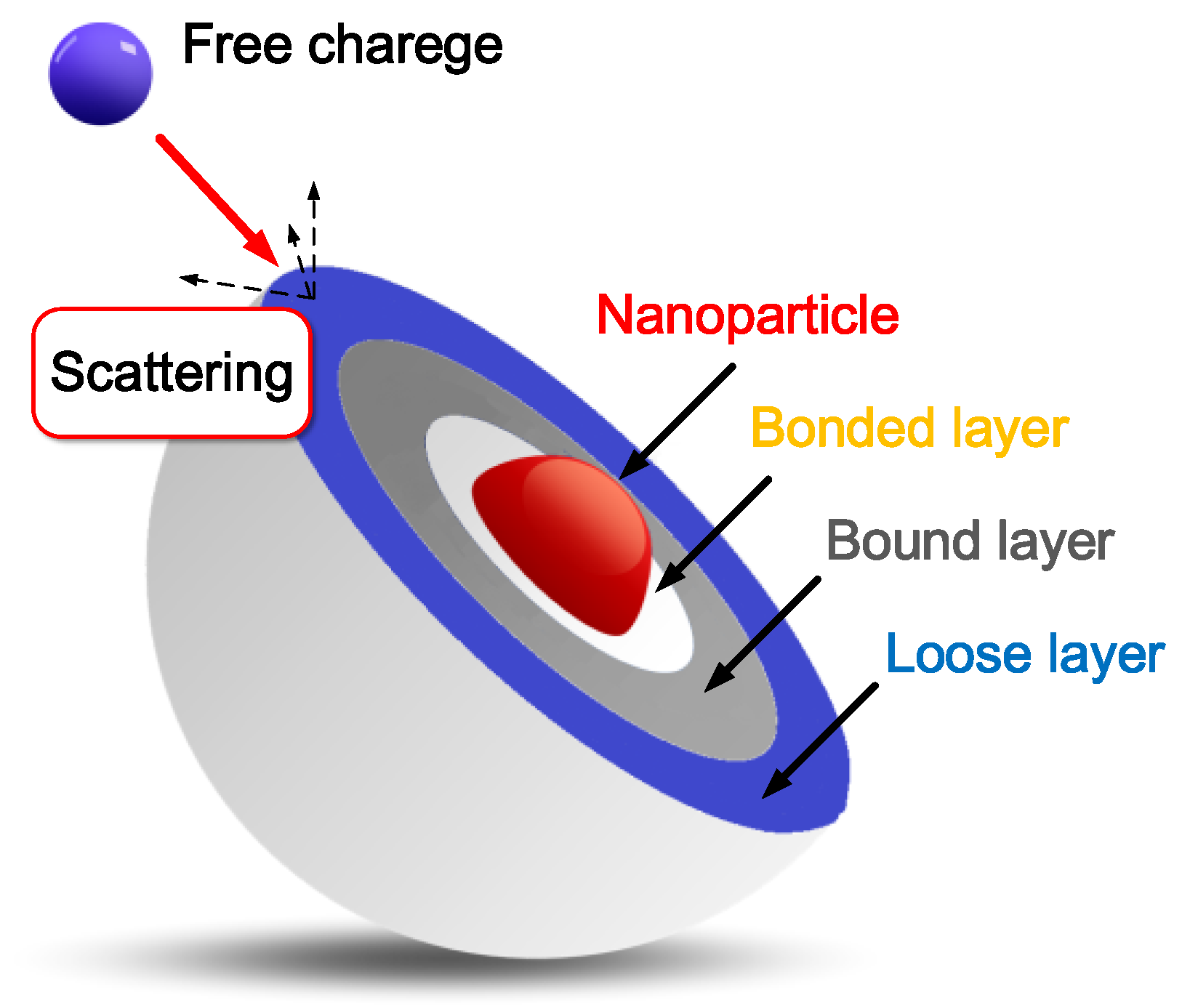
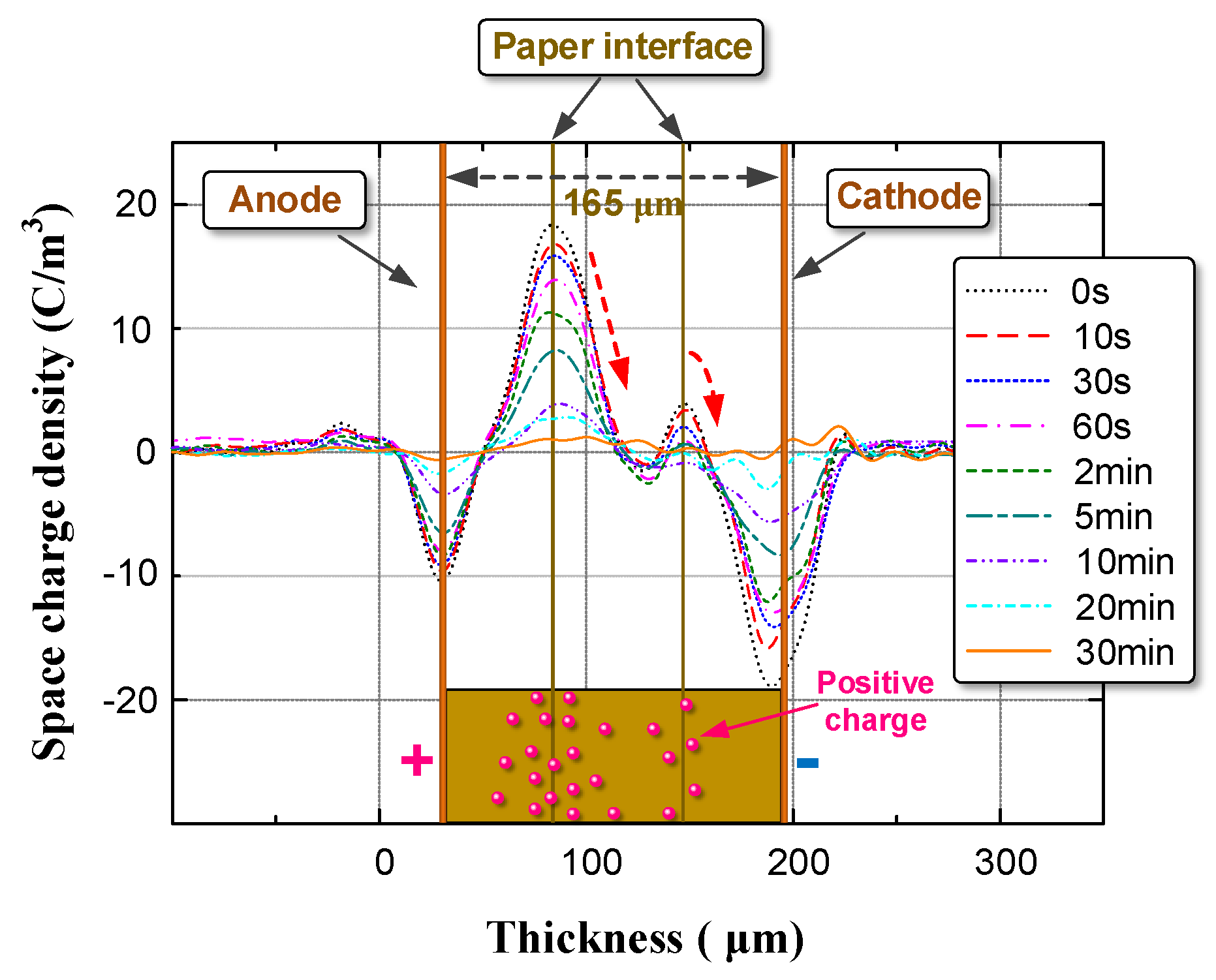
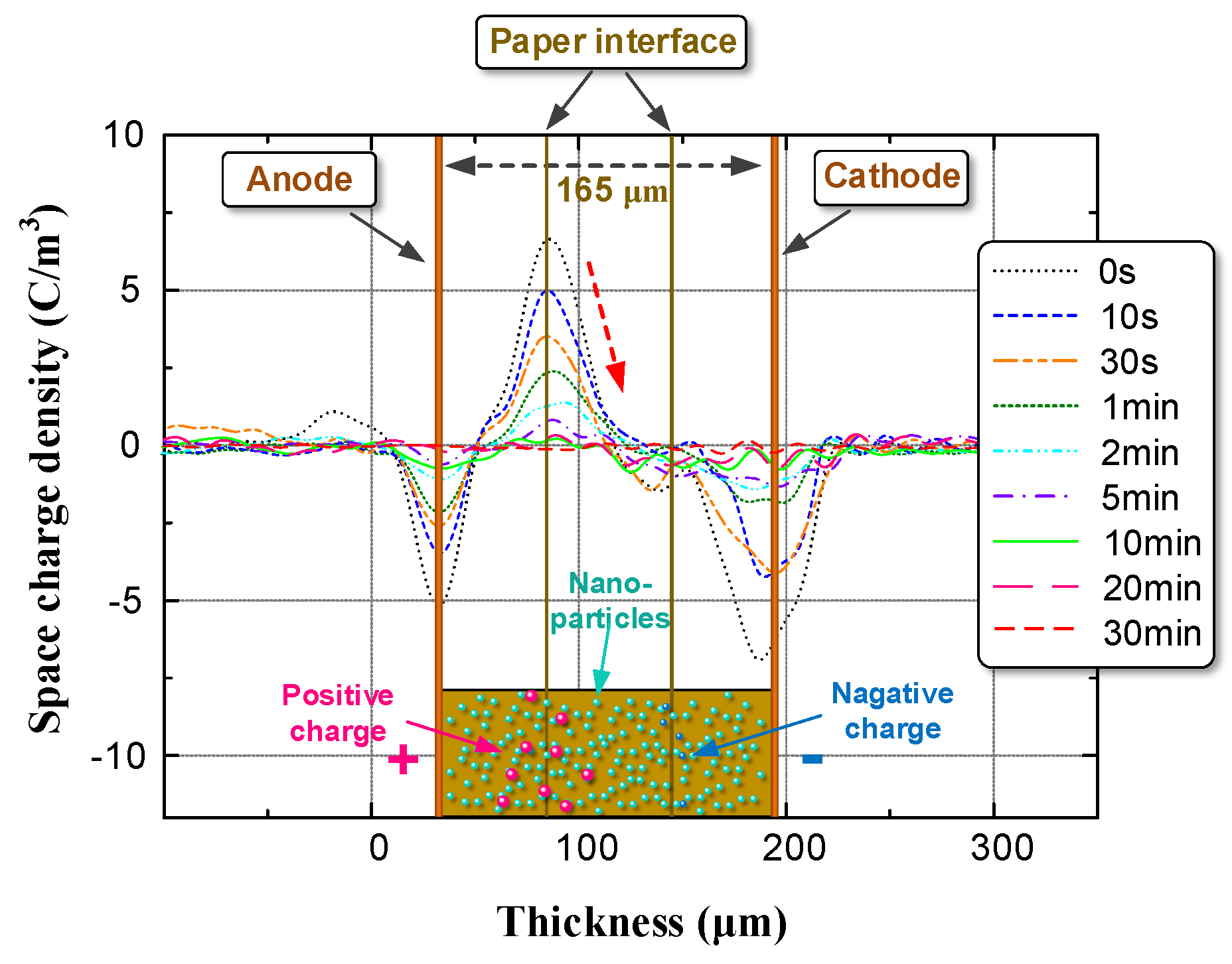
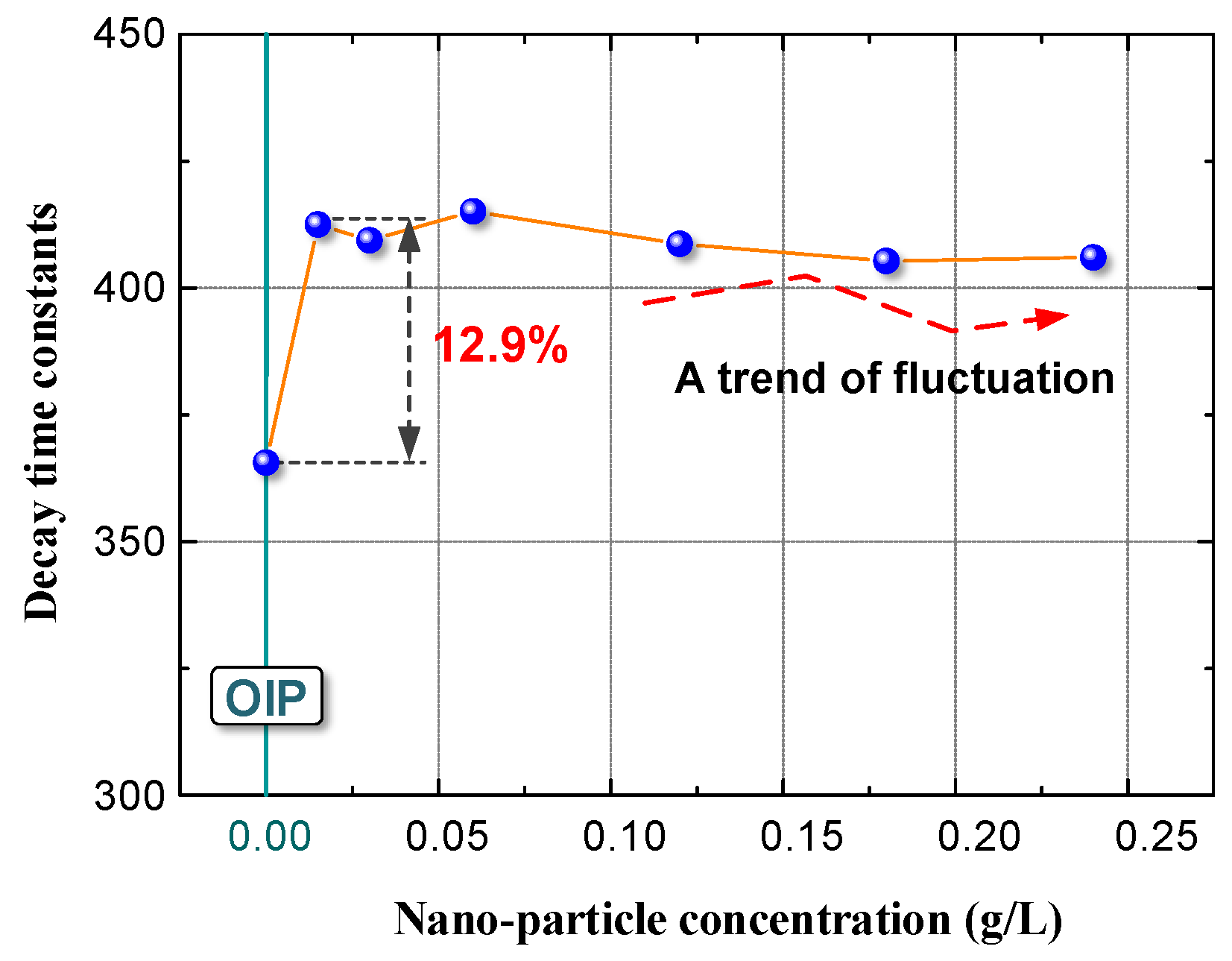
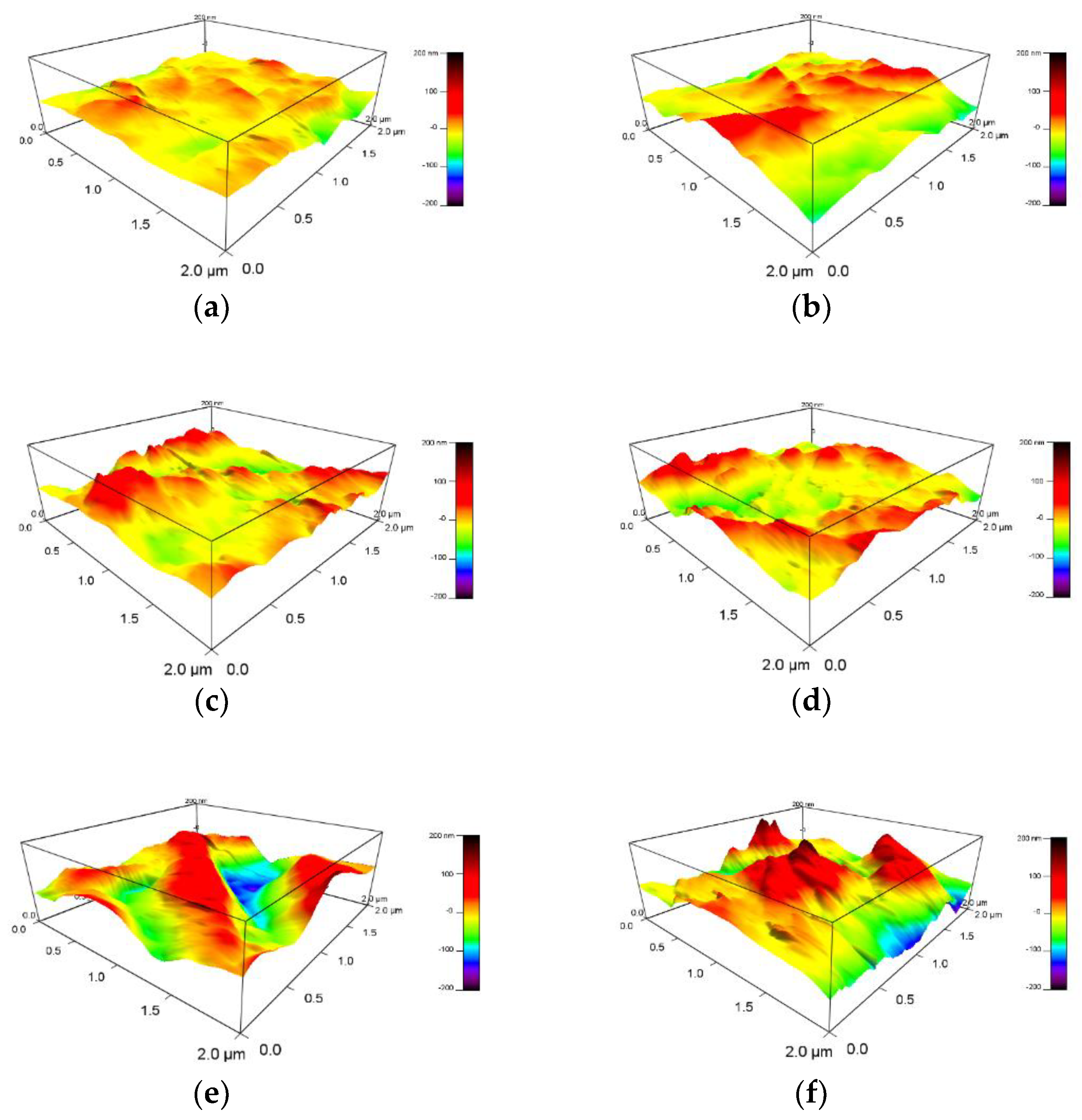

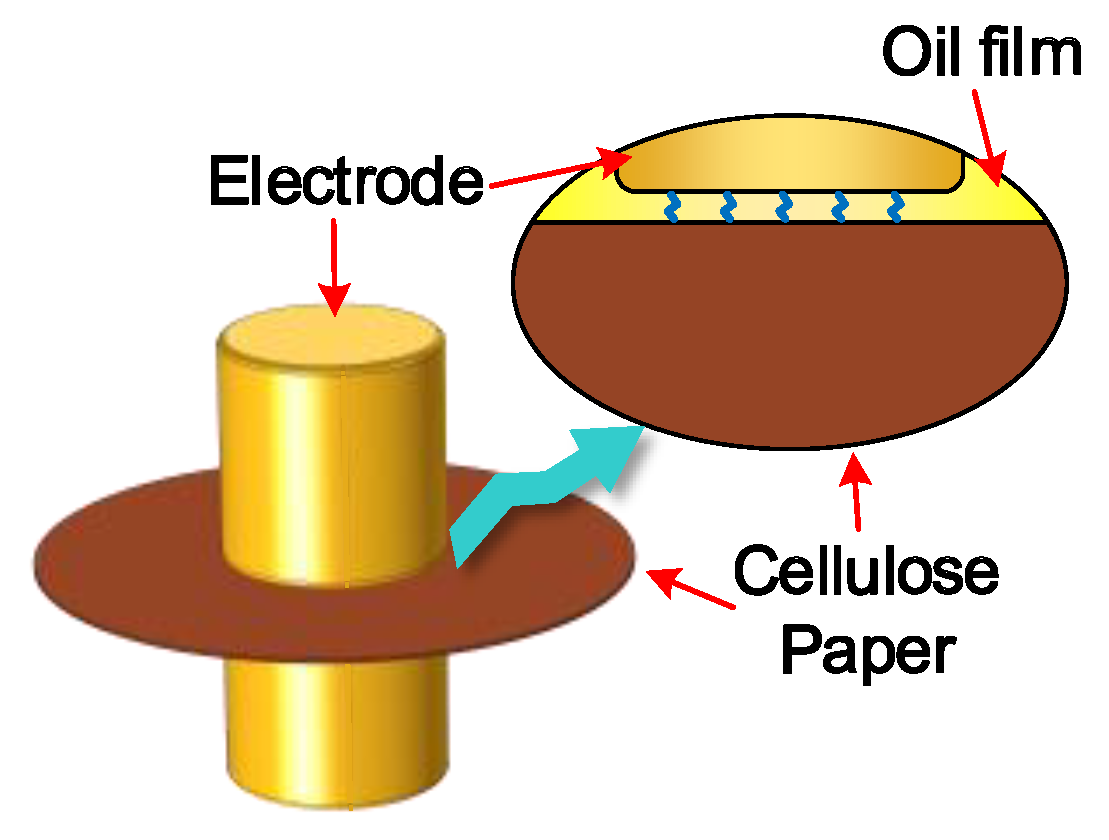
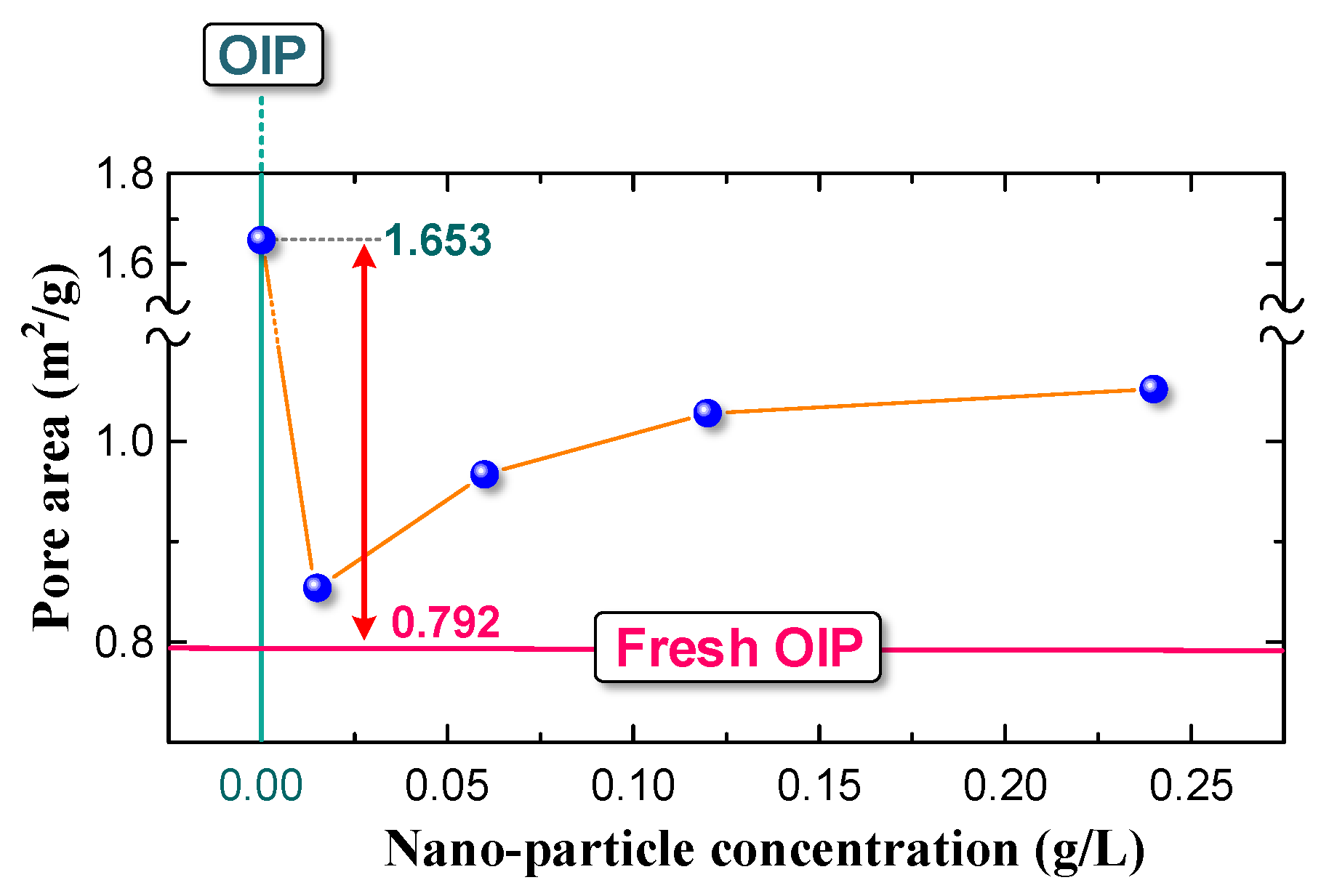
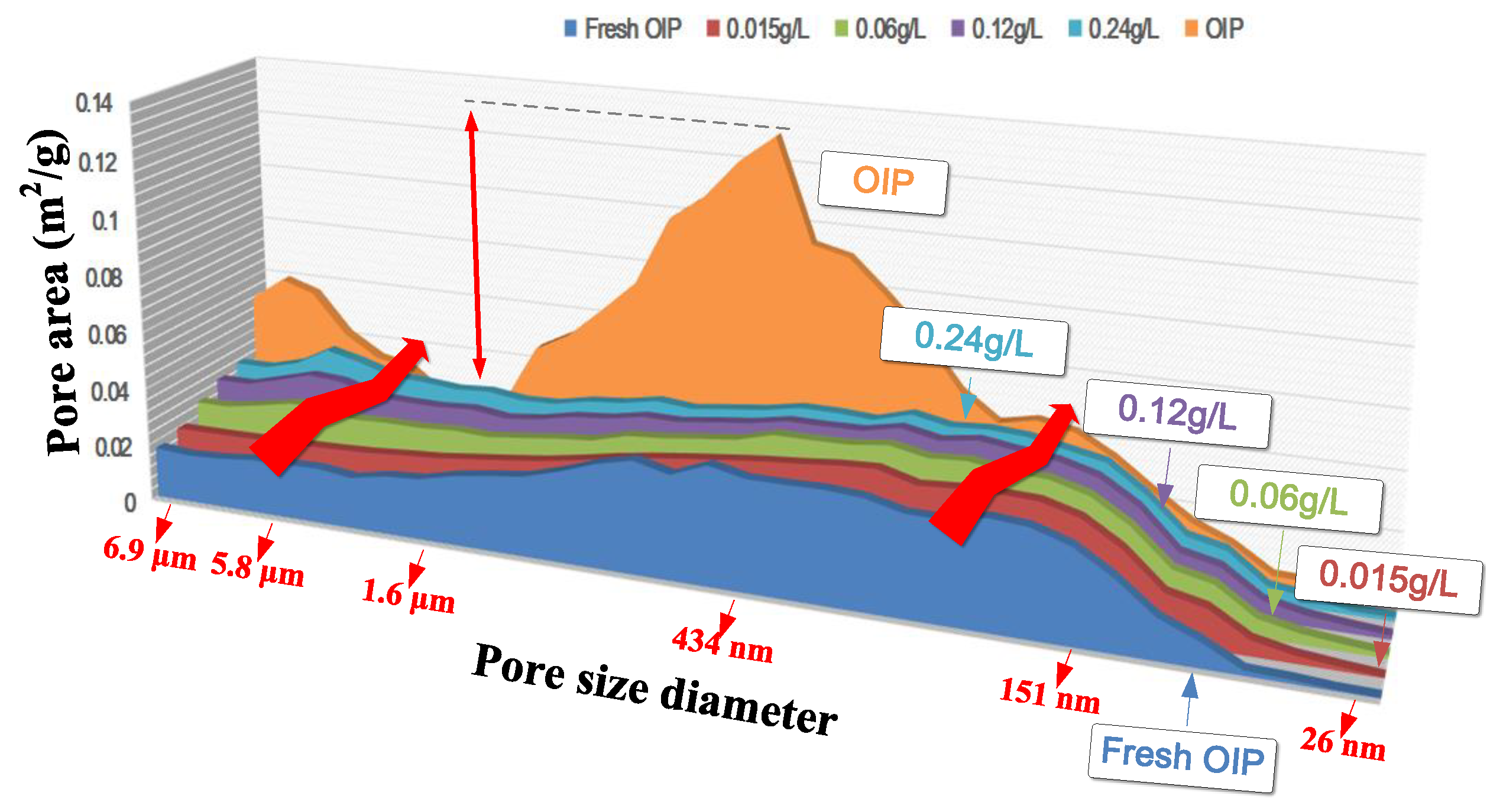
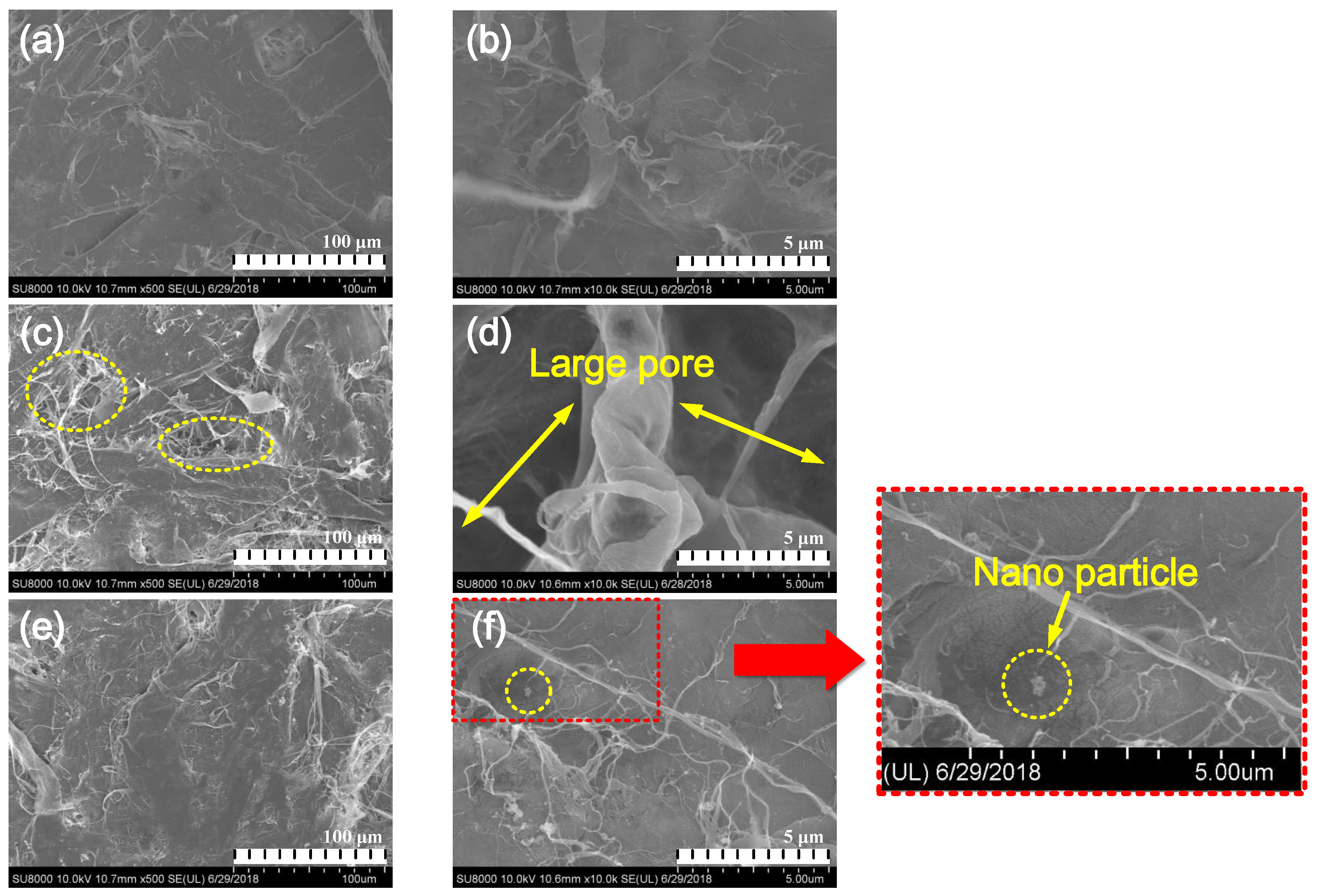
| Electrode | Diameter | Height | Edge Radius | Tip Radius | Material | Gap Distance |
|---|---|---|---|---|---|---|
| Needle | - | - | - | 60 ± 10 μs | Brass | 4 mm |
| Plate | 60 mm | 8 mm | 2.5 mm | - | Brass | |
| Column | 25 mm | 25 mm | 1 mm | - | Brass | - |
© 2018 by the authors. Licensee MDPI, Basel, Switzerland. This article is an open access article distributed under the terms and conditions of the Creative Commons Attribution (CC BY) license (http://creativecommons.org/licenses/by/4.0/).
Share and Cite
Sun, P.; Sima, W.; Zhang, D.; Jiang, X.; Zhang, H.; Yin, Z. Failure Characteristics and Mechanism of Nano-Modified Oil-Impregnated Paper Subjected to Repeated Impulse Voltage. Nanomaterials 2018, 8, 504. https://doi.org/10.3390/nano8070504
Sun P, Sima W, Zhang D, Jiang X, Zhang H, Yin Z. Failure Characteristics and Mechanism of Nano-Modified Oil-Impregnated Paper Subjected to Repeated Impulse Voltage. Nanomaterials. 2018; 8(7):504. https://doi.org/10.3390/nano8070504
Chicago/Turabian StyleSun, Potao, Wenxia Sima, Dingfei Zhang, Xiongwei Jiang, Huangjing Zhang, and Ze Yin. 2018. "Failure Characteristics and Mechanism of Nano-Modified Oil-Impregnated Paper Subjected to Repeated Impulse Voltage" Nanomaterials 8, no. 7: 504. https://doi.org/10.3390/nano8070504
APA StyleSun, P., Sima, W., Zhang, D., Jiang, X., Zhang, H., & Yin, Z. (2018). Failure Characteristics and Mechanism of Nano-Modified Oil-Impregnated Paper Subjected to Repeated Impulse Voltage. Nanomaterials, 8(7), 504. https://doi.org/10.3390/nano8070504




